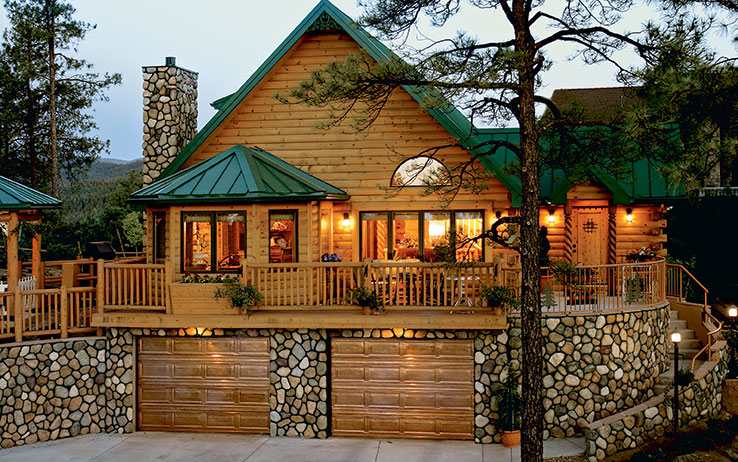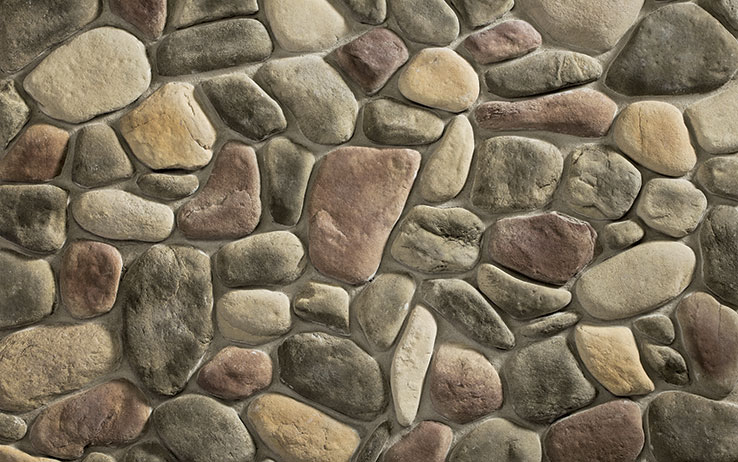
Find the best manufactured, faux stone for your cabin that is durable and beautiful.
Q: How do I go about choosing a high-quality faux stone with all the brands out there today? How do I tell them apart? – Sandy L., via Facebook
A: You seem to have already ruled out natural stone, for understandable reasons. Manufactured stone, also known as stone veneer, is a cost-effective way to bring the natural beauty of the rocks and stones carved by nature to a cabin’s fireplace, porch and interior or exterior walls. Keep in mind, however, that some uses, like the water retention required by a pool or pond, do need natural stone’s hardier attributes, according to Jason Thompson, a spokesperson for the National Concrete Masonry Association (NCMA).
“If you want something that’s going to be in a high-weathering environment, like a border around a pool or a pond, you need natural stone,” he said. “The advantages of a manufactured stone is that it’s significantly cheaper, easier to install and easier to maintain. But you do lose the natural stone durability.”
You’ve asked about brands, but it’s unlikely that anyone, outside the manufacturers themselves, can tell one brand from another, Thompson says. To weed out low-quality products, look for “ASTM-C1670” on a product’s packaging, which indicates that it’s met the industry standard and the minimum criteria for manufactured stone. “If you don’t have one marked ‘C1670’ compliant, that’s the easiest way to tell [the quality is sub-standard],” he says.
Also, be sure to look at stone veneer samples before purchasing to make sure you’re personally satisfied that you’re selecting a product that looks like real stone.
You don’t say whether you’re considering manufactured stone for an exterior or interior use, but that will make a difference, not just in which style to choose but also how it’s installed.
If the veneer is used outside, it must be integrated with the wall’s weather-barrier system, or you risk weather – including rain, ice and temperature extremes – interfering with the stone’s performance. Eventually, incorrect installation could lead to deterioration that might expose the concrete base underneath the stony surface, ruining the effect and risking damage. For that reason, unless you are a sophisticated DIYer, it’s wise to have a professional install stone veneers outside.
For interiors, though, the product needs only a sound backing because you’re not dealing with the extreme environmental elements that pressure the exterior wall envelope, Thompson says.

For those willing and able to take on their own projects, the Masonry Veneer Manufacturers Association, an affiliate of the NCMA, provides detailed instructions, including what tools you’ll need and instructions for various kinds of placement.
Whether you’re contemplating manufactured stone for an indoor or outdoor fireplace, a wall or elsewhere, it is a great choice. Manufactured stone, or stone veneer, lends what Glen Becker at ProVia calls the “wonderment of stone,” with production techniques that nicely mimic the real thing, minus the downsides that include the weight, the cost and the wear that can fade color and shape, depending on the type. In many cases, stone veneer actually retains its color better than nature’s product.
“Part of how ProVia differs is how they make the molds,” Becker says, “starting with authentic stone and allowing for a lot more detail in the edges and the underside of the stone, so that from every angle, the piece that’s on the wall looks like a dead ringer.” (See provia.com/stone.)
Beyond brand names, you’ll be choosing between colors, shapes and textures that you find best fit with the look and feel of your cabin and its landscape. ProVia, like other manufacturers, has a “River Rock” collection, for example, inspired by the smooth, randomly shaped stones found in some U.S. rivers and streams. Other styles include natural-looking stones cut into squared off chunks, with rock created to look like fieldstone, ledgerock and other types. There are also layouts meant to imitate techniques from precise masonry to looser stacking.
While markedly lighter than most natural stone (which itself varies in size, weight, porousness and color), manufactured stone is nevertheless heavy and costly to ship, so most manufacturers rely on local contractors and retailers to showcase and deliver it. Whatever brands you’re shopping, check your local listings or the manufacturers’ websites to find a contractor or retailer near you who can help.

 For those willing and able to take on their own projects, the Masonry Veneer Manufacturers Association, an affiliate of the NCMA, provides detailed instructions, including what tools you’ll need and instructions for various kinds of placement.
Whether you’re contemplating manufactured stone for an indoor or outdoor fireplace, a wall or elsewhere, it is a great choice. Manufactured stone, or stone veneer, lends what Glen Becker at ProVia calls the “wonderment of stone,” with production techniques that nicely mimic the real thing, minus the downsides that include the weight, the cost and the wear that can fade color and shape, depending on the type. In many cases, stone veneer actually retains its color better than nature’s product.
“Part of how ProVia differs is how they make the molds,” Becker says, “starting with authentic stone and allowing for a lot more detail in the edges and the underside of the stone, so that from every angle, the piece that’s on the wall looks like a dead ringer.” (See provia.com/stone.)
Beyond brand names, you’ll be choosing between colors, shapes and textures that you find best fit with the look and feel of your cabin and its landscape. ProVia, like other manufacturers, has a “River Rock” collection, for example, inspired by the smooth, randomly shaped stones found in some U.S. rivers and streams. Other styles include natural-looking stones cut into squared off chunks, with rock created to look like fieldstone, ledgerock and other types. There are also layouts meant to imitate techniques from precise masonry to looser stacking.
While markedly lighter than most natural stone (which itself varies in size, weight, porousness and color), manufactured stone is nevertheless heavy and costly to ship, so most manufacturers rely on local contractors and retailers to showcase and deliver it. Whatever brands you’re shopping, check your local listings or the manufacturers’ websites to find a contractor or retailer near you who can help.
For those willing and able to take on their own projects, the Masonry Veneer Manufacturers Association, an affiliate of the NCMA, provides detailed instructions, including what tools you’ll need and instructions for various kinds of placement.
Whether you’re contemplating manufactured stone for an indoor or outdoor fireplace, a wall or elsewhere, it is a great choice. Manufactured stone, or stone veneer, lends what Glen Becker at ProVia calls the “wonderment of stone,” with production techniques that nicely mimic the real thing, minus the downsides that include the weight, the cost and the wear that can fade color and shape, depending on the type. In many cases, stone veneer actually retains its color better than nature’s product.
“Part of how ProVia differs is how they make the molds,” Becker says, “starting with authentic stone and allowing for a lot more detail in the edges and the underside of the stone, so that from every angle, the piece that’s on the wall looks like a dead ringer.” (See provia.com/stone.)
Beyond brand names, you’ll be choosing between colors, shapes and textures that you find best fit with the look and feel of your cabin and its landscape. ProVia, like other manufacturers, has a “River Rock” collection, for example, inspired by the smooth, randomly shaped stones found in some U.S. rivers and streams. Other styles include natural-looking stones cut into squared off chunks, with rock created to look like fieldstone, ledgerock and other types. There are also layouts meant to imitate techniques from precise masonry to looser stacking.
While markedly lighter than most natural stone (which itself varies in size, weight, porousness and color), manufactured stone is nevertheless heavy and costly to ship, so most manufacturers rely on local contractors and retailers to showcase and deliver it. Whatever brands you’re shopping, check your local listings or the manufacturers’ websites to find a contractor or retailer near you who can help.




